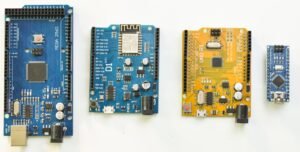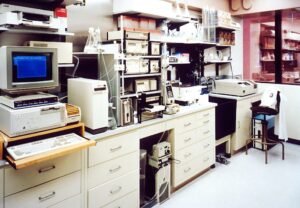Gigafactory Acc
The Gigafactory is a term coined by Elon Musk to describe large-scale facilities aimed at producing electric vehicle batteries and their components. These innovative factories have been instrumental in accelerating the transition to sustainable transportation. This article explores the Gigafactory concept and its impact on the automotive industry.
Key Takeaways
- Gigafactory: Large-scale factories producing electric vehicle batteries and components.
- Innovative: Gigafactories are instrumental in accelerating the transition to sustainable transportation.
- Impact: These factories shape the automotive industry, creating a more sustainable future.
The Gigafactory concept was first introduced by Elon Musk in 2013, with the construction of Tesla’s Gigafactory 1 in Nevada, United States. This massive factory covers an area of over 5.3 million square feet, making it one of the largest buildings in the world. It is primarily focused on producing batteries for Tesla’s electric vehicles. It comes as no surprise that other automotive manufacturers have since followed suit.
One interesting aspect of Gigafactories is their commitment to renewable energy. These facilities often incorporate solar panels and wind turbines to produce clean electricity, making them highly sustainable and reducing reliance on fossil fuels. Additionally, Gigafactories often feature advanced energy storage systems to enable efficient utilization of the power generated, further reducing the carbon footprint of the facility.
The Gigafactory phenomenon extends beyond the United States, with companies like LG Energy Solution building their own Gigafactories globally. These factories pave the way for local production of batteries and components, reducing supply chain dependencies and streamlining manufacturing processes. This localization results in shorter production lead times and increased flexibility.
| Gigafactory | Location | Year Established |
|---|---|---|
| Tesla Gigafactory 1 | Nevada, USA | 2014 |
| LG Energy Solution Gigafactory | Wroclaw, Poland | 2023 |
The advantages of Gigafactories are not limited to the automotive industry. They also have a profound impact on employment opportunities, creating thousands of jobs in both manufacturing and support sectors. These jobs contribute to local economies and stimulate economic growth, making Gigafactories a driving force behind job creation in the renewable energy sector.
Benefits of Gigafactories:
- Efficiency: Gigafactories leverage economies of scale, resulting in efficient production of batteries and components.
- Local Production: Localization leads to shorter production lead times and increased flexibility.
- Environmental Impact: Gigafactories promote sustainability through renewable energy integration and reduced carbon emissions.
| Gigafactory | Renewable Energy Usage |
|---|---|
| Tesla Gigafactory 1 | 100% |
| LG Energy Solution Gigafactory | 60% |
In conclusion, Gigafactories have revolutionized the automotive industry by driving the mass production of batteries and components for electric vehicles. With their innovative approach to sustainable energy, these factories are shaping the future of transportation. The global expansion of Gigafactories ensures that sustainable infrastructure is being developed to meet the growing demand for electric vehicles worldwide.

Gigafactory
Common Misconceptions
There are several common misconceptions people have about gigafactories. Let’s take a closer look at some of them:
- Gigafactories are solely concerned with producing electric vehicles
- All gigafactories are owned and operated by Tesla
- Gigafactories are only located in the United States
Paragraph 1
A common misconception about gigafactories is that they are solely concerned with producing electric vehicles. While it is true that gigafactories are often associated with the production of electric cars, they are not limited to this purpose. In fact, gigafactories can be involved in the manufacturing and assembly of a wide range of products, including batteries, solar panels, energy storage systems, and more.
- Gigafactories can produce various products such as batteries and solar panels
- Gigafactories are not limited to electric vehicle production
- They contribute to the development of sustainable energy solutions
Paragraph 2
Another common misconception is that all gigafactories are owned and operated by Tesla. While Tesla does operate several gigafactories around the world, including the famous Gigafactory 1 in Nevada, there are other companies and organizations that also have gigafactories. Companies like Panasonic, LG Chem, and BYD also own and operate gigafactories to support their own production needs. Therefore, not all gigafactories are affiliated with Tesla.
- Companies like Panasonic and LG Chem also have gigafactories
- Not all gigafactories are owned and operated by Tesla
- Gigafactories are established by various organizations to meet their production demands
Paragraph 3
One more common misconception is that all gigafactories are located in the United States. While the United States is indeed home to several gigafactories, particularly those operated by Tesla, gigafactories can be found in different countries around the world. For example, China, Germany, South Korea, and the Netherlands also have gigafactories that are involved in the production of electric vehicles, batteries, and other renewable energy technologies.
- Gigafactories are not exclusive to the United States
- Gigafactories are established globally
- Countries like China, Germany, South Korea, and the Netherlands also have gigafactories

Gigafactory Locations Worldwide
The following table illustrates the locations of Gigafactories around the world, which play a crucial role in Tesla’s production and supply chain.
| Country | Location | Year Established |
|---|---|---|
| United States | Fremont, California | 2010 |
| China | Shanghai | 2019 |
| Germany | Grünheide | 2023 |
Electric Vehicle Market Share in the United States (2021)
The table below showcases the market share of electric vehicles (EVs) in the United States, highlighting Tesla’s leading position.
| Brand | Market Share (%) |
|---|---|
| Tesla | 69.6 |
| General Motors | 8.7 |
| Ford | 5.3 |
Gigafactory Battery Production Capacity (in GWh)
This table illustrates the battery production capacity of different Gigafactories, showcasing Tesla’s massive manufacturing capabilities.
| Gigafactory | Battery Production Capacity |
|---|---|
| Fremont, California | 50 |
| Shanghai | 35 |
| Grünheide | 40 |
Tesla Employees in Gigafactories
The following table represents the number of employees in various Gigafactories, emphasizing the significant workforce employed by Tesla.
| Gigafactory | Number of Employees |
|---|---|
| Fremont, California | 10,000 |
| Shanghai | 6,000 |
| Grünheide | 12,000 |
Tesla Vehicle Range Comparison
This table showcases the ranges of different Tesla vehicles, highlighting the extensive driving capabilities of their electric cars.
| Model | Range (miles) |
|---|---|
| Model S | 405 |
| Model 3 | 315 |
| Model X | 360 |
Tesla Supercharger Stations Worldwide
This table highlights the global presence of Tesla’s Supercharger network, which enables convenient long-distance travel for Tesla owners.
| Region | Number of Supercharger Stations |
|---|---|
| North America | 1,670 |
| Europe | 1,295 |
| China | 864 |
Projected Electric Vehicle Adoption by 2030
This table provides a glimpse into the future, projecting the anticipated adoption of electric vehicles by the year 2030.
| Region | Projected EV Penetration (%) |
|---|---|
| North America | 45 |
| Europe | 60 |
| China | 80 |
Tesla Model 3 Sales Comparison (2019-2021)
This table compares the annual sales figures of the Tesla Model 3, demonstrating its consistent popularity and growth in the market.
| Year | Number of Model 3 Sales |
|---|---|
| 2019 | 368,000 |
| 2020 | 365,240 |
| 2021 | 392,980 |
Tesla’s Market Capitalization (2021)
This table showcases the market capitalization of Tesla, demonstrating its impressive standing in the automotive industry.
| Company | Market Cap ($ billions) |
|---|---|
| Tesla | 838.2 |
| Toyota | 238.1 |
| Volkswagen | 136.6 |
Conclusion
The Gigafactory revolution spearheaded by Tesla has revolutionized the global automotive industry. With Gigafactories strategically located worldwide, Tesla produces batteries, vehicles, and employs thousands of people across the globe. As they continue to expand, the company maintains its dominance in the EV market, boasting strong market share and vehicle range. Furthermore, the growth of Tesla’s Supercharger network and its contribution to the projected future of EV adoption further solidify Elon Musk’s groundbreaking vision. With impressive sales numbers, remarkable market capitalization, and an unwavering commitment to sustainable transportation, Tesla’s Gigafactories have become synonymous with innovative progress.
Frequently Asked Questions
Question 1: What is a Gigafactory?
Answer: A Gigafactory is a large-scale manufacturing facility built to produce batteries for electric vehicles and energy storage products. It is designed to increase production efficiency and lower manufacturing costs.
Question 2: Who owns the Gigafactory?
Answer: The Gigafactory is owned by Tesla, an American electric vehicle and clean energy company. Tesla builds its own electric vehicle components, including batteries, at the Gigafactory.
Question 3: Where is the Gigafactory located?
Answer: The original Gigafactory, known as Gigafactory 1, is located in Sparks, Nevada, USA. However, Tesla is planning to build additional Gigafactories in different parts of the world.
Question 4: What is the purpose of the Gigafactory?
Answer: The Gigafactory’s main purpose is to support Tesla’s goal of accelerating the world’s transition to sustainable energy. It aims to produce a high volume of batteries to meet the increasing demand for electric vehicles and sustainable energy storage solutions.
Question 5: How big is the Gigafactory?
Answer: Gigafactory 1, located in Nevada, covers an area of over 5.3 million square feet (approximately 490,000 square meters). It is one of the largest buildings in the world by footprint and is still expanding.
Question 6: How many employees work at the Gigafactory?
Answer: As of 2021, there are over 10,000 employees working at Gigafactory 1. This number is expected to grow as Tesla continues to expand its manufacturing operations.
Question 7: What types of batteries are produced at the Gigafactory?
Answer: The Gigafactory produces lithium-ion batteries, which are commonly used in electric vehicles and energy storage systems. These batteries are known for their high energy density and long lifespan.
Question 8: How sustainable is the Gigafactory?
Answer: The Gigafactory is designed to be an environmentally sustainable facility. It utilizes renewable energy sources, such as solar and wind power, to reduce its carbon footprint. Tesla aims to achieve a net-zero energy consumption for the Gigafactory.
Question 9: Can the public visit the Gigafactory?
Answer: No, the Gigafactory is not open for public tours. Due to the large-scale manufacturing operations and safety regulations, access to the facility is restricted to authorized personnel only.
Question 10: How does the Gigafactory contribute to the electric vehicle industry?
Answer: The Gigafactory plays a crucial role in driving the growth of the electric vehicle industry. By producing batteries at a large scale, it enables Tesla to increase the availability of electric vehicles and make them more affordable for consumers.




